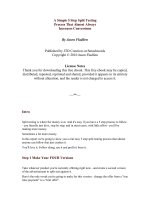simple technical indicators that really work coursebook - larson 2007
Bạn đang xem bản rút gọn của tài liệu. Xem và tải ngay bản đầy đủ của tài liệu tại đây (4.09 MB, 136 trang )
Marketplace Books
Columbia, Maryland
Mark Larson
ThaT Really WoRk
12 simple
Technical
indicaTors
Copyright © 2007 by Mark Larson
Published by Marketplace Books Inc.
All rights reserved.
Reproduction or translation of any part of this work beyond that permitted by section
107 or 108 of the 1976 United States Copyright Act without the permission of the
copyright owner is unlawful. Requests for permission or further information should
be addressed to the Permissions Department at Marketplace Books
®
.
This publication is designed to provide accurate and authoritative information in regard
to the subject matter covered. It is sold with the understanding that neither the author nor
the publisher is engaged in rendering legal, accounting, or other professional service.
If legal advice or other expert assistance is required, the services of a competent
professional person should be sought.
From a Declaration of Principles jointly adopted by a Committee of the American Bar
Association and a Committee of Publishers.
This book, along with other books, is available at discounts that make it
realistic to provide them as gifts to your customers, clients, and staff. For
more information on these long lasting, cost effective premiums, please
call us at 800-272-2855 or e-mail us at
ISBN: 1-59280-290-7
ISBN 13: 978-1-59280-290-6
Printed in the United States of America.
Table of Contents
12 Simple Technical
Indicators that Really Work
From the Publisher v
Meet Mark Larson ix
Introduction xi
Chapter 1: Technical Indicators 101 1
Chapter 2: Moving Averages 11
Chapter 3: Balance of Power 27
Chapter 4: Moving Average Convergence/Divergence (MACD) 43
Chapter 5: Price Rate of Change 51
Chapter 6: Time-Segmented Volume 61
Chapter 7: Relative Strength Index and Time-Segmented Volume 69
Chapter 8: Inertia 77
Chapter 9: Average True Range (ATR) 85
Chapter 10: Stock Scans with Six Important Indicators 95
Chapter 11: ree Investment Strategies at Work
in Any Market 103
Conclusion 109
Trading Resources Guide 113
ix
Mark Larson is a seasoned trader, weekly writer for www.inco-
metrader.com, and educator who has been actively trading the
markets since 1998. His courses on technical analysis and the use
of technical indicators are sought after by many traders. His simple
trading skills have helped thousands of investors of all types make
money during an up, down, or sideways market.
His best selling DVD courses include 12 Simple Indicators at
Really Work, and his best selling books include Technical Chart-
ing for Prots and Trade Stocks Online. With the use of technical
indicators, Mark was able to warn investors of the last bear market
correction that occurred in 2000, and again warns investors to be
careful of the next up and coming correction. One of Mark’s coined
phrases has always been that the “key to success is knowing when
Meet Mark Larson
x
Mark Larson
to buy and when to sell,” which can only be done with the use of
technical indicators.
Mark is the founder of Rolling Along Investments and an instructor
for Investools. He travels throughout the country teaching others
how to become independent investors by using both technical indi-
cators and options. He attributes most of his skills and success to his
very successful mentors Mike D. Coval and Stacy G. Acevedo.
xi
Consider the following short statement from author Mark Larson:
“en came April 2000, when the bull decided to quit
running and appeared to give in to the bear as we began
a true stock market correction, one that many investors
never experienced before.
is wasn’t just a short-term monthly correction; it
truly was a bearish correction that would stay with us
for many months. is bearish correction created big
problems for thousands and thousands of investors who
didn’t have the right mindset and knowledge of what to
do or how to react.”
Larson had just nished writing the book Technical Charting for
Prots that contained this statement in April 2000. It was released
in January 2001. e market then continued lower by about 50%
Introduction
xii
Mark Larson
before stopping in March 2003 and moving higher as the Dow
Jones broke through the previous high of about 12,500 and reached
13,600 by mid June of 2007. Now the question is will it go higher
or lower? Only technical indicators will tell us that! Read on and
nd out which technical indicators are Mark’s favorites now.
The Goal of This Book
e purpose of Larson’s text is to help you understand the power
of technical indicators and the right parameters. ere are over 200
dierent types of technical indicators out there, and he shows you a
list of the ones that are most commonly used. As you read, Larson
asks that you keep this important point in mind.
Basically, a parameter is a number. ink of the number in terms of
your mother’s prized cake recipe. When she bakes that cake, what
would happen if she leaves out one of the key ingredients, like the
our? Or if the recipe calls for half a cup of our and she adds only
a quarter-cup? It would make a big dierence.
What Larson describes to you
here are the technical indicators
that he’s found work well and con-
sistently—regardless of whether
the market is bullish or bearish—as long as you slightly modify the
parameters. Figure 1.1 on page 3 shows an example of the indica-
tors that you’ll learn about throughout this book.
The key to investing in the
stock market when using
technical indicators is
nding the right parameters.
xiii
Introduction
Although Larson admits to being far from the best investor in
the stock market, he’s been very successful at making money for a
living for the past several years. And he attributes this success to
a single factor: his focus on technical indicators and the right pa-
rameters. As a two time best selling author and writer of a weekly
commentary www.incometrader.com, he has a simple process for
helping others become successful. Read on to discover how he can
help you too.
ThaT Really WoRk
12 simple
Technical
indicaTors
1
One thing I’ve always believed is that technical indicators are more
important than fundamentals. Time and again, I’ve seen that the
proper use of technical indicators enables investors to determine
which stocks to buy or sell and—more importantly—when to do it.
Power of Parameters
To eectively utilize technical indicators, you must rst under-
stand that the most essential aspects of these indicators are their
parameters. is is because proper
parameters oer you better entry
and exit points.
Chapter 1
Technical Indicators 101
Technical indicators are
more important than
fundamentals.
2
Mark Larson
Two Main Types of Technical Indicators
e list in Figure 1.1 demonstrates some of the dierent types of
technical indicators. But by no means should you think that this
list is entirely comprehensive. Rather, dozens more indicators exist,
including support levels, moving averages, linear regression lines,
volume bars, stochastics, ease of movement, average true range, and
so on. ere are three leading indicators I want to bring to your
attention in Figure 1.1: time-segmented volume (TSV©), money
stream, and balance of power (BOP©). I also want to bring two
dierent styles of indicators to your attention:
• Lagging indicators, which basically move after prices move
• Leading indicators, which change before prices change
You’re probably pretty familiar with the three indicators I’ve
starred in gure 1.1 because they’re included in Worden Brothers’
TC 2000©. I’ve been using the TC 2000© for many years because
I believe it to be one of the premier charting services available. I
nd the TC 2000© to be extremely powerful because it focuses on
these three leading indicators, which are based on price movement
and volume. Also I have found that other indicators such as ease
of movement and average true range (prophet.net) indicators are
extremely helpful too.
3
Technical Indicators 101
The Leading Role That Volume Plays
Let’s talk about volume for a moment. It’s really impor-
tant to remember that volume goes with the trend. is means
that it’s normal for volume to increase as prices increase and
to decrease as prices decrease—which you see occurring
in Figure 1.2.
When volume is moving with the
trend in the direction of the price, it’s
telling you one thing and one thing
only. is crucial piece of information is that the prevailing trend is
healthy and that it’s a good relationship.
FIGURE 1.1
Volume plays an
absolutely essential role
in the stock market.
4
Mark Larson
When prices are declining, and you see a corresponding decline in
volume, don’t panic! Keep in mind that it’s normal for volume to
decline as well.
is means that downside breakouts from price patterns often occur
with relatively low volume. If volume expands as prices decline, this
emphasizes the bearishness of the
breakout. at’s because circum-
stances in which declining prices
couple with expanding volume rep-
resent overall greater enthusiasm
among sellers. More volume basically means more sellers during a
downtrend and more volume in an uptrend means more buyers; and
as we all know, more is better because it will force the price of the
stock to move further.
Evolution of Mark Larson’s Trading Style
I’ve been trading in the market since I was 24 years old. The only dif-
ference between then and now—and I’m 42—is that I now use techni-
cal indicators, which I’ve done for the last 10 years. When I was in real
estate at age 24, I was taught that you should always buy and hold.
Unfortunately, I started seeing some of my assets head in the wrong
direction. So I began to take a more aggressive approach, managing
my own money. I learned that there are times when you should sell
some of your best stocks, which you may have had for a long time, and
there are other times when you should buy some that you’ve never,
ever considered buying before. The only way I could identify those
stocks was by using technical indicators, as well as scans/searches.
We’ll discuss scans/searches a bit later in chapter 10, when I give
you an easy way to follow and track them.
!
Increased volume is often
greater than the average
volume over the past
20 trading days.
5
Technical Indicators 101
As with all upside breakouts, volume is key. It must expand be-
yond the breakout to indicate enthusiasm. erefore, a change in
the supply and demand is in favor of demand. So it follows that
volume has a major impact on what individual stocks or the index
itself will do.
Figure 1.2 provides an example of an uptrend. You see that I’ve
drawn a lot of vertical lines. Believe it or not, some stocks still go
up—and others still go down. at said, I can tell you that the most
successful traders really don’t care if the stock market goes up, down,
or sideways. You may have heard the saying, “e stock market drops
FIGURE 1.2
For color charts go to www. traderslibrary.com/TLEcorner
6
Mark Larson
four to eight times faster than it goes up.” We’ve certainly witnessed
that in the past, most recently at the latter part of 1989 and of 1999.
But as Figure 1.2 shows, we had an upward trend with a correspond-
ing increase in volume.
In Figure 1.3, you see the breakout again, with yet another
upward movement.
It shows that the trend was moving in an upward direction, with a
positive increase in volume. So as the saying goes, make the trend
your friend!
FIGURE 1.3
For color charts go to www. traderslibrary.com/TLEcorner
7
Technical Indicators 101
Chapter Summary
• Technical indicators are more important than fundamentals.
• Technical indicators and their corresponding parameters tell you
what to buy, what to sell, and more importantly when.
• Proper parameters help you to determine when to enter the
market—and when to exit.
• e two types of technical indicators are lagging and leading.
• Volume plays an essential role in technical indicators, increasing
and decreasing along with price trends.
• In an environment with declining prices, it’s normal to see a sub-
sequent decline in volume.
• When volume increases and prices decline, that is an indication
that sellers are more enthusiastic.
8
Mark Larson
1. Why are technical indicators better than fundamentals?
a. Technical indicators are statistically driven and
always right
b. ey allow you to nd potential stocks, and more
importantly, tell you when to buy and sell them
c. Fundamentals are always lagging
d. Fundamentals work best in long-term buy and
hold situations
2. Which of the following is a leading indicator?
a. Moving averages
b. Relative strength
c. Money stream
d. Stochastics
3. Which of the following statements about volume is false?
a. It is normal for volume to increase as prices go up
b. In an upside breakout, if volume expands, that is very
favorable for the stock
c. It is normal for volume to increase as prices decline
d. If volume increases on a downside breakout, that
emphasizes the overall bearishness of the move
Self-test questions
9
Technical Indicators 101
4. For more aggressive trading, the author believes that:
a. Fundamentals trump technicals
b. You should always buy and hold. Long-term transactions
always end up making money
c. Volume is more important than technical indicators
d. You should use technical indicators
5. What is the most essential aspect of using technical
indicators?
a. Proper parameters
b. at you never ignore or override their signals
c. Volume
d. at you use 12 of them
For answers, go to www.traderslibrary.com/TLEcorner
11
Chapter 2
Moving Averages
A moving average is the sum of whatever you’re examining. In this
case, I’m talking about the closing prices of a stock. For example,
a 20–, 30–, 50–, 100–, or 200-day moving average is then divided
by the total number of days, resulting in the average price of the
stock. A 30-day period is commonly used for short-term buy and
sell signals.
As stocks move above the 30-day moving average, it’s said that the
stock has greater upside potential; and, as the price drops down
below the 30-day moving average it’s said that the stock has greater
odds of moving lower at that time. Such moving averages are help-
ful when determining levels of support and resistance. As a habit,
I have found that once a stock drops below the 30-day moving
average, it may be best to place a stop loss order at a select price. I’ll









